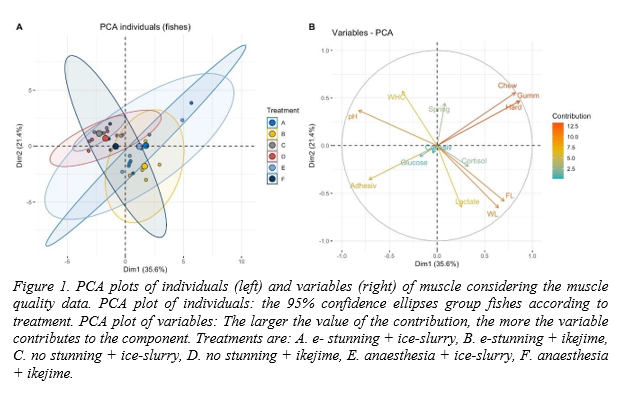STUNNING AND SLAUGHTER METHODS IN GILTHEAD SEABREAM: ANIMAL WELFARE AND MUSCLE ASSESSMENT
Introduction
Global aquaculture production has surpassed capture fisheries, reaching 111 million tonnes in 2022, with projections to continue growing. This expansion raises concerns over fish welfare, particularly in relation to humane stunning and slaughter methods. The EU has established directives emphasising the minimization of suffering, especially during slaughter. While methods like electrical and mechanical stunning are deemed humane, practices such as ice asphyxiation and CO2 exposure are considered inhumane. Despite increased awareness, many fish, including gilthead seabream, are still slaughtered without stunning, resulting in significant stress and muscle deterioration. This study investigates the effects of different stunning and slaughter techniques (electrical stunning, anaesthesia, and no stunning) followed by either ice-slurry or ikejime on the welfare and meat quality of gilthead seabream.
Materials and Methods
Conducted at the Estação Piloto de Piscicultura de Olhão (EPPO) in Portugal, this study involved 32 adult gilthead seabream. Fish were housed in three controlled outdoor tanks and acclimatized for 7 days before bio-loggers were surgically implanted to monitor heart rate and internal temperature. After a recovery period, the fish were subjected to various stunning and slaughter treatments: electrical stunning, anaesthesia, or no stunning, followed by either ice-slurry or ikejime. Physiological and behavioural data, including heart rate, blood samples, and muscle quality parameters, were collected. Data were analysed using linear mixed models (LMM) for heart rate, internal temperature and blood parameters, one-way ANOVA for muscle quality, and PCA for muscle quality and plasma datasets.
Results
We found notable differences in fish behaviour, heart rate, physiological responses, and muscle quality based on the stunning/slaughter method employed. Electrical stunning led to an immediate loss of visual consciousness, except for one fish that retained its vestibulo-ocular reflex (VOR). Fish slaughter with ice-slurry showed delayed loss of movement and more stress indicators, as well as significantly lower heart rates compared to those slaughtered with ikejime. Cortisol levels were highest in fish slaughtered by ice-slurry without prior stunning, indicating greater stress. Glucose levels were elevated in most treatments, with the highest increase seen in fish subjected to anaesthesia followed by ikejime. Other physiological markers, such as lactate, calcium, and potassium levels, varied significantly with the treatment. Electrical stunning followed by ikejime resulted in higher lactate and potassium levels. Muscle quality analyses showed that fish slaughtered only with ikejime or previously stunned with anaesthesia had softer, less chewy, and more water-retentive muscle than fish slaughtered with ice-slurry or electrically stunned. These two later groups also resulted in greater water and fat loss than the fish anaesthetised before slaughter.
Discussion
This study demonstrates that different slaughter techniques significantly impact both the physiological stress responses and muscle quality of gilthead seabream. Fish that were not stunned experienced prolonged consciousness and stress, particularly when slaughtered in ice-slurry, where they remained conscious for up to 18 minutes. Although anaesthesia and electrical stunning resulted in some unconsciousness, fish still showed stress responses during slaughter with ice-slurry, suggesting that these methods may not always be fully effective when in combination with ice-slurry. Ice-slurry induced bradycardia and higher cortisol levels, with unstunned fish exhibiting a faster temperature drop and greater stress. Muscle quality was best preserved in fish stunned with anaesthesia before slaughter, while electrical stunning led to lower pH and undesirable texture. In conclusion, while anaesthesia and ikejime produced the best outcomes for fish welfare and meat quality, electrical stunning requires further validation, and the development of automated ikejime could offer a humane and effective alternative for the industry.

